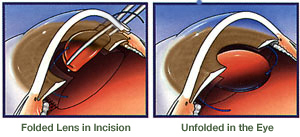|
||
History of Intraocular Lens ImplantsIn the old days the only way we could replace the focusing power of the lens we removed was with a thick cataract (coke bottle) glass - glasses that we remember older people wearing years ago. Nowadays, we are quite fortunate because we can replace the natural lens by implanting an artificial, clear, plastic lens. The discovery of these lenses came as a result of World War II pilots, and the injuries sustained when bullets would strike the plastic canopy of their aircraft, causing small shards of plastic to go into their eye. In the late fourties, Howard Ridley was an RAF ophthalmologist looking after these unfortunate pilots, and he realized that the polymethylmethacrylate (PMMA) acrylic of the canopies, was made of an inert material that was compatible witrh eye tissue. In 1949 he replaced a cataractous natural lens with an artificial plastic lens, and he was viewed with suspicion and derision by other ophthalmologists for doing this unheard of thing. It took the rest of ophthalmology 30 years to figure out how to do the same thing. There has been an evolution of artificial lenses since then. The current versions are actually placed within the capsular bag of the old, natural lens and they are now made of polymethylmethacrylate (PMMA) with an ultra violet blocking substance in them. We also have a number of newer, flexible materials (silicone or acrylic) which can be folded, and therefore, are placed through a smaller incision.
|
|
|||
|
This page last updated on December 30, 2003.
Web Page Programmer Turnaround Type and Graphics

